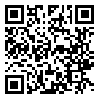Volume 19, Issue 1 (1-2020)
ijdld 2020, 19(1): 51-60 |
Back to browse issues page
Maryam Aalaa1 
 , Mohammad Reza Mohajeri-Tehrani2
, Mohammad Reza Mohajeri-Tehrani2 
 , Ghobad Ramezani1
, Ghobad Ramezani1 
 , Mohammad Reza Amini3
, Mohammad Reza Amini3 
 , Maryam Aboeerad2
, Maryam Aboeerad2 
 , Mahnaz Sanjari *
, Mahnaz Sanjari * 
 4
4

 , Mohammad Reza Mohajeri-Tehrani2
, Mohammad Reza Mohajeri-Tehrani2 
 , Ghobad Ramezani1
, Ghobad Ramezani1 
 , Mohammad Reza Amini3
, Mohammad Reza Amini3 
 , Maryam Aboeerad2
, Maryam Aboeerad2 
 , Mahnaz Sanjari *
, Mahnaz Sanjari * 
 4
4
1- Center for Educational Research in Medical Sciences (CERMS), Department of Medical Education, School of Medicine, Iran University of Medical Sciences (IUMS), Tehran, Iran
2- Endocrinology and Metabolism Research Center, Endocrinology and Metabolism Clinical Sciences Institute, Tehran University of Medical Sciences, Tehran, Iran
3- Diabetes Research Center, Endocrinology and Metabolism Clinical Sciences Institute, Tehran University of Medical Sciences, Tehran, Iran
4- Diabetes Research Center, Endocrinology and Metabolism Clinical Sciences Institute, Tehran University of Medical Sciences, Tehran, Iran ,mahnaz.sanjari@gmail.com
2- Endocrinology and Metabolism Research Center, Endocrinology and Metabolism Clinical Sciences Institute, Tehran University of Medical Sciences, Tehran, Iran
3- Diabetes Research Center, Endocrinology and Metabolism Clinical Sciences Institute, Tehran University of Medical Sciences, Tehran, Iran
4- Diabetes Research Center, Endocrinology and Metabolism Clinical Sciences Institute, Tehran University of Medical Sciences, Tehran, Iran ,
Abstract: (2610 Views)
Background: Peripheral neuropathy is one of the most common problems in diabetic patients. The increased risk of Diabetic Foot Ulceration (DFU) and amputation would be a complication of diabetic neuropathy. The aim of this study was to compare the DFU healing in different severity classification of neuropathy.
Methods: This is a retrospective study that was conducted over a two-year period from April 2016 to March 2018 according to the information of patients records with Diabetes Mellitus (DM) referred to clinic of diabetes and metabolic disorders of Endocrinology and Metabolism Research Institute of Tehran University of Medical Sciences. Wound healing criteria including area, depth and healing duration were studied. Accordingly, changes in the area and depth of wounds were evaluated and reported during the first, third and sixth months after baseline. Data were analyzed using descriptive and inferential statistics using SPSS software version 16.
Results: The results of the study of patients with neuropathic ulcer showed that males and age group of 56 to 65 years had the highest frequencies. In addition, most of these patients suffered from type 2 DM (79%). The rate of wound healing, which was measured by area and depth of wound in three time periods, differed in different severity classification of neuropathy; at mild level of neuropathy the area and depth of wound decreased faster but in severe neuropathy, duration of wound healing in both mentioned criteria has increased. Regarding to the increase in the duration of DM, the healing time increased too. However the rate of wound healing decreased with increased age (p-value = 0.001).
Conclusion: Evidence suggests that early identification of neuropathy can reduce the incidence of DFU and amputation. Due to the slow healing of the size and depth of the wound in diabetic patients with severe neuropathy, it is necessary to prevent DFU by conducting preventive care and educational interventions.
Methods: This is a retrospective study that was conducted over a two-year period from April 2016 to March 2018 according to the information of patients records with Diabetes Mellitus (DM) referred to clinic of diabetes and metabolic disorders of Endocrinology and Metabolism Research Institute of Tehran University of Medical Sciences. Wound healing criteria including area, depth and healing duration were studied. Accordingly, changes in the area and depth of wounds were evaluated and reported during the first, third and sixth months after baseline. Data were analyzed using descriptive and inferential statistics using SPSS software version 16.
Results: The results of the study of patients with neuropathic ulcer showed that males and age group of 56 to 65 years had the highest frequencies. In addition, most of these patients suffered from type 2 DM (79%). The rate of wound healing, which was measured by area and depth of wound in three time periods, differed in different severity classification of neuropathy; at mild level of neuropathy the area and depth of wound decreased faster but in severe neuropathy, duration of wound healing in both mentioned criteria has increased. Regarding to the increase in the duration of DM, the healing time increased too. However the rate of wound healing decreased with increased age (p-value = 0.001).
Conclusion: Evidence suggests that early identification of neuropathy can reduce the incidence of DFU and amputation. Due to the slow healing of the size and depth of the wound in diabetic patients with severe neuropathy, it is necessary to prevent DFU by conducting preventive care and educational interventions.
Type of Study: Research |
Subject:
Special
Received: 2019/07/1 | Accepted: 2020/02/1 | Published: 2019/11/1
Received: 2019/07/1 | Accepted: 2020/02/1 | Published: 2019/11/1
| Rights and permissions | |
 |
This work is licensed under a Creative Commons Attribution-NonCommercial 4.0 International License. |
